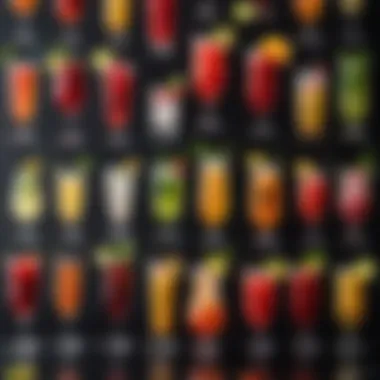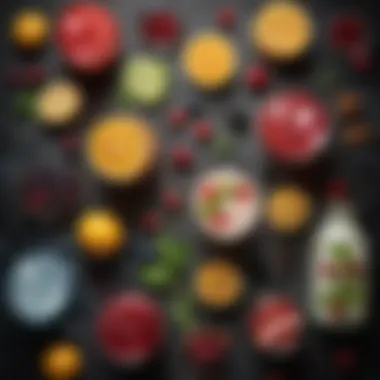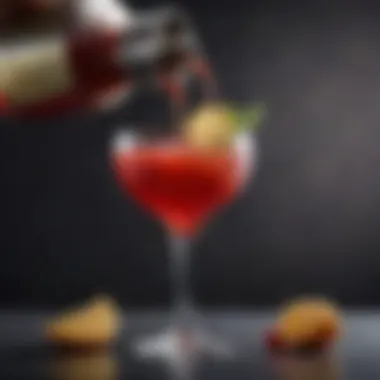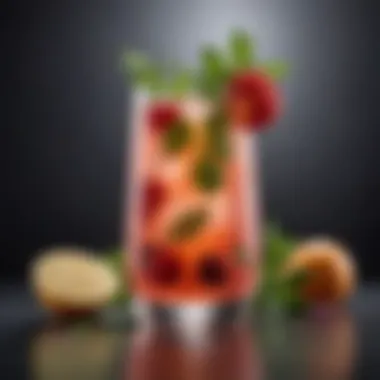Mocktails vs Cocktails: Distinctions and Overlaps


Intro
The beverage industry reflects diverse tastes and preferences. As social settings evolve, two categories gain notable attention: mocktails and cocktails. Understanding their distinctions and similarities goes beyond mere flavor profiles. It involves exploring their cultural roots, health implications, and modern consumption trends. This analysis provides a thorough comparison that not only illuminates each category's unique characteristics but also evaluates their relevance in a world that increasingly values health and wellness.
Recipe Overview
Mocktail Madness
A mocktail, often referred to as a non-alcoholic cocktail, is designed to provide a flavorful experience without the effects of alcohol. They are often colorful, refreshing, and can be customized to individual tastes, catering specifically to those who choose abstinence from alcohol for personal, health, or religious reasons.
Classic Cocktail
A cocktail combines various ingredients, often including spirits. They balance flavors, creating a rich tapestry of taste that can evoke memories or celebrations. Cocktails have a storied place in culture, often associated with festivities and social gatherings.
Ingredients List
Main Ingredients
- Mocktails: These typically include fruit juices, syrups, herbal infusions, and soda. Popular fruits are lime, mint, and berries.
- Cocktails: Key ingredients are spirits, fruit liqueurs, bitters, and mixers like tonic or soda water.
Optional Ingredients
- Mocktails: Garnishes such as edible flowers or spices can enhance presentation and flavor.
- Cocktails: Unique bitters and specialized mixers broadening the flavor profile can be beneficial.
"Both mocktails and cocktails show that creativity in beverage preparation can bring social delight, irrespective of alcohol content."
As society shifts towards mindful drinking, both categories adapt to meet evolving consumer expectations. Readers can now delve into histories and techniques that define these drinks.
Intro to Mocktails and Cocktails
In the modern culinary landscape, beverages play a significant role in social gatherings and meal experiences. The exploration of mocktails and cocktails illustrates the diversity available in drink choices. Understanding these two categories is crucial for appreciating their unique characteristics as well as their overlapping features. This section will emphasize the importance of distinguishing between these two types of beverages.
Defining Cocktails
Cocktails are mixed drinks that traditionally contain alcohol among other ingredients. Their formulation can include spirits, fruit juices, syrups, bitters, and garnishes. Cocktails vary greatly in flavor profiles, presentation, and technique of preparation.
The origin of cocktails can be traced back to the 19th century when they became a popular choice for social gatherings in Europe and America. The versatility in ingredients and the creativity involved in crafting cocktails have led to numerous classic recipes. For instance, drinks like the Martini, Mojito, and Old Fashioned have secured their places in bars and restaurants worldwide.
Cocktails are not just drinks; they are often an experience. The act of mixing ingredients, the aesthetics of presentation, and the ambiance of consumption all contribute to the enjoyment. Moreover, cocktails frequently carry cultural significance, reflecting regional tastes and seasonal availability of ingredients.
Defining Mocktails
Mocktails, in contrast, refer to non-alcoholic beverages that imitate the complexity and presentation of cocktails. They provide the same intricate combination of flavors but without the inclusion of alcoholic components. This characteristic makes mocktails a popular choice for those who prefer to abstain from alcohol but desire the same social experience.
The emergence of mocktails can be linked to a growing awareness of health and wellness trends. Many consumers are seeking low-alcohol or alcohol-free options that still provide enjoyment during social occasions. Ingredients often found in mocktails include fresh fruits, herbs, spices, and various syrups. Popular examples are the Virgin Mojito, Shirley Temple, and Pina Colada mocktail.
Mocktails are also an avenue for creativity. Mixologists experiment with flavors and visuals to attract those who may not drink alcohol but still appreciate complexity in their beverages. As the demand rises, many restaurants and bars now feature extensive mocktail menus, allowing guests to indulge while remaining sober.
Historical Overview
Understanding the historical context of mocktails and cocktails provides a foundation for appreciating their cultural significance today. The evolution of these beverages reflects broader social dynamics and changes in consumer preferences over time. This overview examines the origins and transformations of both categories, illustrating how they became integral parts of social interactions and celebrations.
The Origins of Cocktails
Cocktails have a storied history that dates back to the early 19th century. The term "cocktail" first appeared in print in 1806, defining a mixture of spirits, sugar, water, and bitters. These ingredients laid the groundwork for the cocktail culture we recognize today.
The early cocktails were often simple, reflecting the limited availability of ingredients. The trend gained momentum with the publication of Jerry Thomas's The Bartender's Guide in 1862. This book popularized various cocktail recipes and indicated a shift where cocktails began to be seen as art. Bartenders started experimenting with flavors, resulting in creations that showcased creativity and complexity.


Prohibition in the United States during the 1920s played a crucial role in shaping cocktail culture. Many individuals turned to speakeasies, where secretive drink mixing flourished. As a result, the cocktail grew in popularity, becoming a symbol of rebellion and sophistication. After the repeal in 1933, cocktails re-entered mainstream culture, further evolving with international influences and modern distilleries.
The Emergence of Mocktails
Mocktails, by contrast, are a relatively recent development. The term "mocktail" emerged in the late 20th century, representing non-alcoholic beverages that mimic the complexity and presentation of traditional cocktails. As the focus on health and wellness increased in the 21st century, mocktails gained traction as consumers began seeking alternatives to alcoholic beverages.
Initial iterations of mocktails were often basic fruit juices or sodas. However, this changed as mixologists and restaurants recognized the demand for sophisticated non-alcoholic options. The aim was to create drinks that are enjoyable and visually appealing.
Today, mocktails feature a variety of ingredients including herbs, spices, and intricate syrups to enhance flavor profiles. Their rise reflects an increasing awareness of inclusivity in drinking culture, catering to those who prefer not to consume alcohol while still enjoying social experiences.
In recent years, the growth of mocktails indicates a shift toward a more inclusive approach in social drinking.
The historical exploration of both mocktails and cocktails reveals not only their respective origins but also how they have adapted over time. This journey illustrates the ongoing relationship between society and beverage choices, making it essential to understand these elements as we analyze contemporary preferences.
Cultural Significance
The cultural significance of mocktails and cocktails extends beyond mere enjoyment of beverages. These drinks serve as a reflection of societal habits, preferences, and values. Understanding this aspect provides insight into how communities engage during social events and the norms surrounding alcohol consumption. It's important to recognize the role these drinks play in various traditions and celebrations.
Social gatherings often center around cocktail consumption. Cocktails can evoke a sense of sophistication and celebration. They have become embedded in cultural practices. Events such as wedding receptions, corporate events, and holiday parties frequently feature cocktails as a staple. The aesthetic appeal and variety of cocktails contribute to their popularity. This trend emphasizes creativity and individuality as mixologists often experiment to create unique flavor profiles.
Conversely, mocktails have gained prominence particularly in recent years, aligning with evolving cultural attitudes toward alcohol. The rise of the mindful drinking movement highlights a shift where individuals prioritize wellness over traditional drinking habits. Mocktails symbolize inclusivity in social gatherings. They allow everyone to partake in the experience without compromising personal choices or health considerations. Mocktails often mimic the complexity of cocktails. This encourages individuals who abstain from alcohol to enjoy flavorful beverages.
Mocktails provide a solution for social situations, promoting inclusivity and engagement without alcohol consumption.
The importance of both cocktails and mocktails in different cultural settings further showcases the range of social experiences. Each beverage can facilitate conversations and connections among diverse groups of people. Thus, understanding the cultural context around both will deepen one's appreciation for the breadth of beverage options available.
Ingredients Analysis
The significance of analyzing ingredients in both mocktails and cocktails is multifaceted. Understanding the diverse components gives insight into the flavor profiles, health implications, and overall consumer experience. Ingredients not only define the drink but also dictate how it integrates into social cultures. In this section, we delve into the common ingredients utilized in cocktails, the key components for crafting mocktails, and an examination of ingredient quality.
Common Ingredients in Cocktails
Cocktails typically embrace a wide assortment of ingredients that contribute to their complexity and appeal. The backbone of many cocktails includes spirits such as vodka, gin, rum, tequila, and whiskey. Each of these spirits have unique flavor profiles that allow for a diverse range of mixing possibilities.
Other essential elements include:
- Mixers: Tonic water, sodas, and juices help dilute the stronger spirits while adding flavors.
- Bitters: These concentrated flavorings introduce depth and complexity.
- Fresh Ingredients: Herbs, fruits, and spices can be muddled in or used as garnish for both visual appeal and enhanced taste.
Understanding these components transforms how one appreciates a cocktail.
Key Components of Mocktails
Mocktails present a non-alcoholic alternative without sacrificing the fun of flavorful drink combinations. The core components of mocktails generally include:
- Syrups: Simple syrup, grenadine, or flavored syrups add sweetness.
- Fresh Juices: Citrus juices like lime and orange amplify freshness.
- Herbs and Spices: Mint, basil, and ginger can create vibrant flavors.
Mocktails often use similar mixers and fresh ingredients to cocktails, making them appealing to those who prefer not to consume alcohol. The creativity in mocktail preparation can lead to exceptionally tasty drinks that do not compromise on flavor or experience.
Comparative Ingredient Quality
When comparing ingredients, it's essential to evaluate the quality. High-quality ingredients elevate both mocktails and cocktails, enhancing flavor and presentation.
For cocktails:
- Premium spirits tend to enhance the drinking experience, providing greater depth and smoother finishes.
For mocktails:
- Freshly squeezed juices and natural syrups tend to be far superior to their pre-made counterparts. Using high-quality ingredients can significantly alter the taste, making the drink more enjoyable.


"Quality ingredients are essential for creating a well-balanced and flavorful beverage, whether it is alcoholic or not."
In summary, an in-depth analysis of ingredients helps in understanding how they contribute to each drink’s identity. This knowledge can lead to more intentional choices for both drink enthusiasts and casual consumers alike.
Preparation Techniques
The concept of preparation techniques is pivotal in understanding both mocktails and cocktails. This section emphasizes how the method of crafting these beverages not only influences their flavor profiles but also affects the overall drinking experience. Mastery over preparation techniques can transform simple ingredients into complex combinations that appeal to the senses. For those who appreciate the art of drink-making, understanding these techniques is essential for both enjoyment and creativity.
Mixology Basics for Cocktails
Cocktail preparation is a blend of art and science that combines various ingredients to create a balanced and flavorful drink. The essence of mixology lies in its techniques, which include shaking, stirring, muddling, and layering. Each method has its purpose and impacts the drink's texture, taste, and presentation.
- Shaking: This technique is often used for cocktails that include fruit juices or other ingredients that need to be thoroughly combined. Shaking with ice not only cools the drink but also adds air, creating a frothy texture.
- Stirring: Generally used for spirit-forward cocktails, stirring is a gentle method that helps to combine the ingredients while maintaining clarity and smoothness. It minimizes dilution compared to shaking.
- Muddling: This involves pressing herbs or fruits in the bottom of a glass to release their flavors. It's essential for cocktails that require fresh ingredients, such as a Mojito.
- Layering: This is a visual technique where different ingredients are poured over the back of a spoon to create distinct layers in a drink. It requires precision and can enhance the aesthetic appeal of a cocktail.
Practicing these basic techniques gives aspiring mixologists the tools needed to craft drinks that both look and taste exceptional. Furthermore, the choice of glassware can augment the drinking experience, as certain glasses are designed to enhance specific drinks.
Crafting Mocktails Efficiently
Mocktails offer a diverse range of flavors and experiences without the inclusion of alcohol. While crafting mocktails may at first seem simpler than cocktails, there are several efficient techniques that can enhance both flavor and presentation.
- Infusing: Using infused syrups or spirits can add depth to mocktails. For example, infusing simple syrup with herbs or spices allows for unique flavor profiles that cater to sophisticated palates.
- Syrups and Purees: Utilizing high-quality syrups and purees can elevate a mocktail's taste. Whether it’s berry purees or flavored syrups, these ingredients can provide a rich foundation for the drink.
- Garnishes: Just like in cocktails, the visual appeal of a mocktail is greatly enhanced by thoughtful garnishing. Fresh fruits, edible flowers, or aromatic herbs can add color and aroma, making the beverage more inviting.
- Carbonated Mixers: Adding sparkling water or tonic can introduce effervescence, creating a refreshing experience that mirrors the sensation of classic cocktails.
Employing these techniques for mocktails not only makes the preparation quicker but also ensures that the final product is satisfying and enjoyable. The efficiency in crafting mocktails can be particularly appealing for gatherings, where a variety of drinks may be served to accommodate different preferences.
The art of drink-making is not just about ingredients, but also about technique and presentation. Both mocktails and cocktails can provide an exquisite experience when prepared with care.
Health Considerations
The analysis of health considerations associated with mocktails and cocktails is critical, especially in today's health-conscious society. Many individuals pay closer attention to their lifestyle choices, resulting in increased scrutiny of their drinking habits. Understanding the impact of alcohol on health and exploring non-alcoholic alternatives offers insights that can guide choices effectively.
Alcohol Consumption and Health
The consumption of alcohol has been a topic of debate among health professionals. Regular intake can lead to various health issues, such as liver disease, addiction, and cardiovascular problems. Many studies suggest that excessive alcohol consumption increases the risk of certain cancers and can destabilize mental health.
However, moderate drinking may have some benefits, like a potential decrease in heart disease risk. The key factor here becomes moderation. The distinction between light, moderate, and heavy drinking is critical, as it fundamentally changes the health implications. The Centers for Disease Control and Prevention defines moderate drinking as up to one drink per day for women and up to two drinks for men.
Yet, these recommendations might not suit everyone. Some individuals prefer to abstain entirely from alcohol due to personal, health, or cultural reasons. This shifting focus leads many to explore mocktails. Mocktails deliver the experience of a cocktail without the associated risks of alcohol consumption.
Nutritional Aspects of Mocktails
Mocktails are gaining traction for their nutritional advantages. Unlike cocktails, which often contain high-calorie alcoholic spirits and added sugars, mocktails can be thoughtfully crafted with fresh ingredients. These beverages can be lower in calories and sugar, especially when using natural sweeteners or fresh fruit juices.
- Fresh Ingredients: Many mocktails utilize fresh fruits, herbs, and spices that can offer vitamins and antioxidants. Ingredients like berries, mint, and ginger not only enhance flavor but also contribute essential nutrients.
- Hydration: Mocktails can be hydrating. While cocktails can dehydrate, mocktails made with plenty of water or tonic water can provide a refreshing solution without compromising hydration levels.
- Customization: Individuals can tailor mocktails to suit their health goals. Whether it is reducing sugar or incorporating superfoods, mocktails allow for a flexible choice that caters to various dietary needs.
"Mocktails provide a refreshing alternative that suits everyone, from health enthusiasts to casual drinkers."
Trends in Beverage Choices
The trends in beverage choices reflect broader societal shifts and evolving consumer preferences, especially in relation to lifestyle and dietary needs. This article investigates these trends in the context of mocktails and cocktails, highlighting their significance in today's beverage landscape. The growing awareness of health issues, coupled with a desire for social inclusivity, drives many drinkers to explore both categories, promoting a deeper understanding and appreciation for each.
Rising Popularity of Mocktails
In recent years, there has been a notable increase in the consumption of mocktails. This surge is brought about by several factors. Health-conscious consumers are opting for non-alcoholic options due to various reasons ranging from weight management to mental wellness. The shift represents a more informed approach to drinking, recognizing that enjoyment does not have to be equated with alcohol.
Mocktails offer a diverse range of flavors and ingredients that appeal to a wide audience. They often incorporate fresh fruits, herbs, and artisanal syrups, providing a gourmet experience without the side effects of alcohol. Additionally, mocktails cater to young people who wish to engage socially without the need to consume alcohol. This demographic shift unveils new opportunities in the beverage market, leading to a richer variety of non-alcoholic products available at bars and restaurants.
Some factors contributing to the rise include:


- Increased health awareness among consumers.
- Demand for diverse and flavorful beverage options.
- Growing presence in social gatherings and events.
"Mocktails have become synonymous with sophisticated drinking culture, embodying both health and taste."
In essence, mocktails are making their mark not just as alternatives to cocktails but as significant players in their own right.
Cocktail Evolution in Modern Culture
Cocktails have a rich history and have evolved significantly in modern culture. The past few decades have seen a revival of cocktail craftsmanship, with bartenders adopting a more artisanal approach to mixology. The influence of culinary arts on cocktail creation has heightened, introducing garden-fresh ingredients and innovative techniques to traditional recipes.
Today, cocktails are more than just drinks; they are a form of art, showcasing the creativity and skills of bartenders. Ingredients are sourced with care, and presentations focus on aesthetics, often resembling intricate works of art. Moreover, the cocktail culture has embraced sustainability, with many establishments prioritizing eco-friendly practices in sourcing and waste disposal.
Here are a few key elements of cocktail evolution:
- The integration of local and seasonal ingredients.
- Trends towards sustainability and eco-conscious practices.
- Influence of global flavors, expanding traditional boundaries.
The Role of the Alcohol Industry
The alcohol industry plays a significant role in shaping the experiences and preferences surrounding both cocktails and mocktails. This sector encompasses a wide range of products and services, including the production, distribution, and marketing of alcoholic beverages. Understanding its role in this article is important for several reasons. Firstly, the alcohol industry influences consumer choices through branding and advertising strategies. These strategies often highlight the craftsmanship of cocktails while promoting the inclusivity of mocktails.
Secondly, the industry's economic impact cannot be overlooked. The revenue generated from cocktails provides vital support for many businesses, from bars and restaurants to distilleries. This financial incentive fosters innovation in beverage development, creating an environment where new cocktails and mocktails can flourish. Moreover, regulatory considerations are also crucial in understanding how the industry operates. Legal restrictions around alcohol sales can influence what types of drinks are available, which in turn shapes consumer behavior.
Market Dynamics of Cocktails
The market for cocktails is dynamic and ever-evolving. Trends within this market often reflect changes in consumer tastes and societal attitudes towards drinking. In recent years, there has been a noticeable shift towards craft cocktails. This movement emphasizes high-quality ingredients and innovative mixing techniques. Bartenders take on a role similar to chefs, focusing on flavor, presentation, and the overall experience of enjoying a cocktail.
"Craftsmanship and creativity are at the forefront of cocktail culture today."
Additionally, seasonal and locally sourced ingredients are becoming popular. This approach not only supports local economies but also enhances the freshness and appeal of cocktails. Social media plays a strong role in this dynamic as well, with visually stunning drinks being shared widely, setting trends that impact consumer preferences.
Challenges persist in the marketplace, such as the increasing awareness of health issues connected to alcohol consumption. The rise of health-conscious consumers is forcing cocktail makers to adapt. This adaptation often manifests in lower-alcohol options or the use of organic and non-GMO ingredients to appeal to a broader audience.
Mocktails as a Competitive Niche
Mocktails represent a fascinating and growing niche within the beverage market. As more individuals seek alternatives to traditional alcoholic drinks, mocktails have gained in popularity. This rise reflects a broader trend towards health and wellness, as consumers become aware of the implications of alcohol on their well-being.
The mocktail space has almost no limits when it comes to creativity. Bartenders and mixologists now showcase their talents in crafting complex flavors without alcohol. Utilizing fresh fruits, herbs, and premium mixers can create beautifully presented beverages that rival cocktails in taste and aesthetic appeal.
Mocktails not only cater to non-drinkers but also to those looking for a refreshing option that excludes alcohol. Events such as weddings and corporate gatherings have started offering elaborate mocktail menus, emphasizing their growing acceptance in social occasions.
Furthermore, the increasing emphasis on inclusivity is driving the mocktail movement. They offer a way for everyone to partake in social drinking culture without the effects associated with alcohol. This is significant because it acknowledges the preferences of diverse groups, including sober individuals and those who simply wish to enjoy a delicious drink without intoxicating effects.
In summary, the alcohol industry plays a critical role in promoting both cocktails and mocktails. The market mechanics shaped by diverse consumer preferences continue to influence how these beverages are perceived and consumed. As the industry evolves, so too will the landscape of drinks available, providing exciting opportunities for both mixologists and patrons alike.
Epilogue
In drawing this exploration to a close, it is essential to consider the significance of mocktails and cocktails within the broader context of beverage culture. Each category offers unique attributes that cater to varying preferences and social norms. Cocktails, with their spirit-forward foundations, serve as a traditional choice for many, epitomizing craftsmanship and sophistication. Mocktails, on the other hand, represent inclusivity and health-conscious choices, appealing to those who demand flavorful alternatives without the intoxicating effects of alcohol.
Summary of Differences and Similarities
Understanding how mocktails and cocktails differ, yet converge, enhances appreciation for both. While cocktails often rely on alcoholic bases and complex mixers, mocktails thrive on creativity with non-alcoholic ingredients.
- Key Differences:
- Similarities:
- Alcohol Content: Cocktails contain alcohol, while mocktails do not.
- Preparation Techniques: Cocktails frequently require advanced mixology skills, whereas mocktails can be simpler to prepare.
- Cultural Perception: Cocktails are traditionally associated with celebration, mocktails resonate with inclusivity and health.
- Both categories engage in creativity and presentation.
- Each attracts a broad audience.
- They share core ingredients such as citrus, herbs, and mixers, although applications vary.
As the lines between these two beverage categories blur, it's important to note how they can coexist and be appreciated for their distinct qualities.
Future of Mocktails and Cocktails
The future landscape of mocktails and cocktails appears vibrant, with growing trends directing consumer preferences. The shift towards health-centric lifestyles indicates that mocktails will continue to rise in prominence, serving a market that desires flavorful experiences without alcohol's impacts. On the other hand, cocktails will also adapt, focusing on quality ingredients and unique flavors to appeal to a more discerning palate.
- Trends to Watch:
- Increased demand for low-alcohol and no-alcohol options.
- Experimentation with exotic flavors and local ingredients.
- A surge in mixology workshops promoting both cocktails and mocktails.
In summary, understanding the nuanced relationship between mocktails and cocktails is not merely an academic exercise. Rather, it reinforces the importance of choice in beverage culture, allowing individuals to make informed decisions tailored to their preferences and values.







